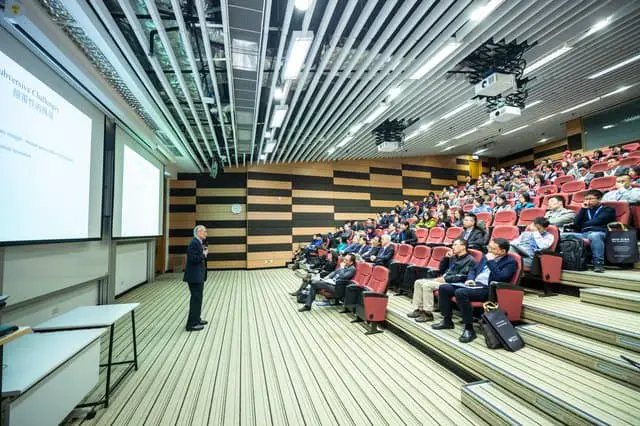5 Learning Styles to Consider for Memorable Presentations
When preparing a presentation, one of the first questions that come to mind is, how do I make the presentation of my ideas interesting? How do you attract the attention of those who are in the audience?
There is no consensus on foolproof tricks to satisfy the audience in a presentation, and each researcher certainly has tips on this based on their personal experience.
However, there is an aspect that often eludes attention and directly influences the appeal that the material exposed has on the audience: the different learning styles.
Professionals who want to succeed in their corporate presentations should know the different learning styles deeply. After all, each individual has their way of capturing information and sending it to the brain to turn it into knowledge.
Thinking about this challenge for presenters, we elaborated this article with the primary learning styles. By dominating each of them, you’ll be able to create personalized and more efficient presentations that meet the expectations of all participants.
What are Learning Styles?
Learning styles are cognitive skills that each person uses to fix specific topics, implying that learning a subject varies from person to person.
From the strategy of personal knowledge, one has more efficiently with a style and more incredible difficulty understanding information with others.
The Vark method, developed by the New Zealand professor Neil Fleming and Colleen Mills, proposes that learning takes place through five skills: auditory, visual, kinesthetic, reading and writing, and multimodal (when learning occurs through two or more skills).
VARK is an acronym that designates the four modes of learning: Visual, Auditory, Read/Write, and Kinesthetic.
5 Learning Styles to use when structuring Public Presentations
1. Visual learning style
The visual learning style is the one in which the person learns through vision. The easiest to assimilate information is recorded in graphs, videos, images, diagrams, maps, symbols, and lists.
People with a visual learning style tend to take notes to assimilate something or record it in memory; they are not satisfied or do not get along just by listening to the presenter.
For you to capture the attention of a visual audience, your presentation needs some features. Some rich features that can boost presentations are:
- Graphics;
- Tables;
- Mind maps;
- Photography;
- Apostille.
2. Auditory learning style
The person with the sharpest aural style can learn by listening to information. In this way, the individual can participate in discussions, explain concepts, listen to podcasts, read aloud, and listen to recordings of lessons.
People who have an auditory learning style, when they hear some information, their brain memorizes it.
So during a presentation it is expected that they express themselves and repeat the content to memorize certain subjects, even though the ideas have not gone through great reflection before being exposed to the public.
Knowing this, see what you need when setting up your presentations to cater for these people:
- Songs;
- Stories;
- Jokes;
- Podcasts extracts.
3-4. Reading/Writing
It is the modality that differs because it is tied to written content. People who identify with this style have ease in dealing with information expressed in the form of words.
In addition, they are people who have the facility to express abstract knowledge in written language.
They prefer to study through books, workbooks, dictionaries, online texts, articles, and research because they find ways to learn more quickly. Most of them are people who also like to read a lot.
5. Kinesthetic learning style
This term may seem a little strange, but if we search the origin and meaning of this word, we will realize that it is associated with the perception of muscle movements.
At this point, you may think, but what does this have to do with learning style?
The relationship of the kinesthetic learning style with muscular movements is because specific individuals develop the ability to learn through practical situations of life.
That is, they are highly active. They are those who do not cling too much to theories.
Imagine those who are seen as agitated people. In the case of school children, teachers often consider them hyperactive. Even as adults, they don’t get to spend much time listening to a story or reading a lengthy text is too quiet a place.
The ideal for this public is not too dull and monotonous; otherwise, they can stand up from their chairs and go away or stay a period outside the auditorium room.
Here are the tips to keep people with the characteristics of the style of learning Kinesthetic interested in your presentation:
- Hold debates;
- If possible, take short breaks;
- Move on the stage;
- Give practical examples,
- Avoid being only in theory;
- Make provocations and inquiries.
Keeping these main learning styles in mind, it is essential to decentralize the focus of the presentation structure of what you as an exhibitor find most interesting and think of a balanced way to meet these diverse demands.
This is especially true in presentations to large audiences, in which the exhibitor tends to want to offer an impact presentation.
With a great diversity of information, technological resources, or a lot of interactivity, it often forgets whether it will capture the attention of the majority.
Given this knowledge of different learning styles, the idea is to create a clear, objective presentation and coordinate appeals that satisfy the four types.
| Learning Styles VARK | |
| 1. Visual | Visual learning responds better to facial expressions and body language, so it is worth investing in direct contact with the audience at specific times rather than just reading materials. |
| 2. Auditory | Auditory learners also like stimuli such as audio recording presentations. They tend to be very participatory in the question session after the presentation, so control your time to ensure this moment of interaction. |
| 3-4 Reading/Writing | These individuals have ease in transforming abstract knowledge into written language, so having slides with research’s, books, articles, dictionaries, online texts, lists extracts would be a tip. |
| 5. Kinesthetic | Kinesthetic learning responds better to more participatory interactions, such as representation, practical demonstrations, and direct requests made to the public. |
-
Want to Stand Out? 15 Key Tips for an Awesome Presentation

Presentation skills are often taken for granted, and developing and practicing these skills will give you a huge advantage. There is nothing less engaging than a dispassionate speaker flipping through slides for a set amount of time. To stand out, follow these key steps and turn an okay presentation into an awesome one! The fifteen…
-
11 Best Body Language Tips For Engaging Presentations (#11 is Underrated)

Growing up, we were always taught how we should have manners while talking to others and that there were some things we could not do in front of people like sprawling or even putting our elbows on the table while eating because it was rude. In the examples above, the rudeness comes from gestures, not…
Conclusion
Learning styles are the way each person uses to learn the proposed content, and this is because each person has eased with a particular style and more difficulty learning from others. Therefore, each person is unique in their way of learning!
The presenter must adapt his presentation to the primary intelligence, which is also the secret of good interpersonal communication.
Learning styles represent part of our five senses – vision, hearing, touch, smell, and taste. Each person usually has one or more of them developed.
References and Further Reading
Your Guide To Understanding And Adapting To Different Learning Styles. Cornerstone.








